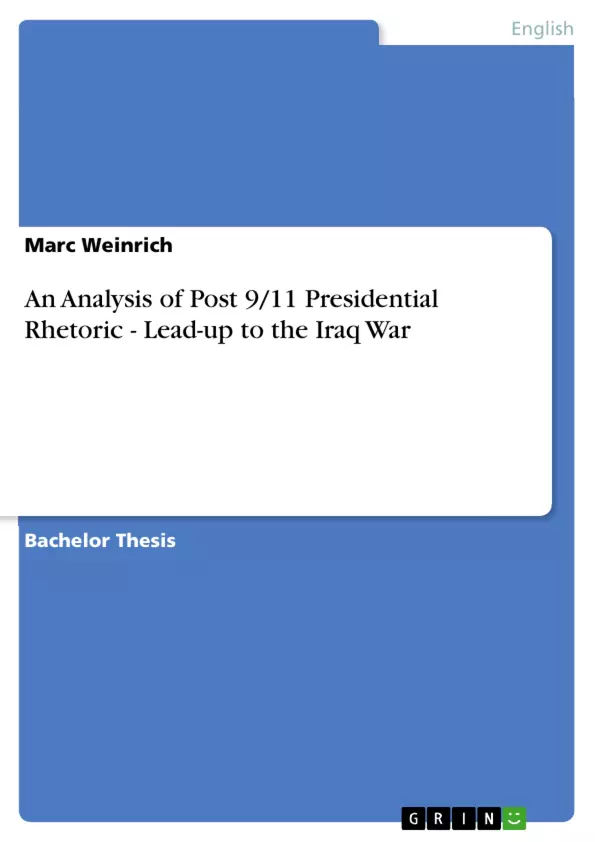On the morning of May 1st, 2003 President George W. Bush landed on the aircraft carrier U.S.S. Abraham Lincoln off the coast of San Diego, California, announcing from its deck that “major combat operations in Iraq have ended” (George W. Bush, May 1st, 2003). On the prominent banner behind him, it said: “Mission Accomplished”. The war had only begun one and a half months prior to this event and currently (October, 2009) American troops are still deployed and involved in combat in Iraq. The mission of the Iraq war was certainly not accomplished on May 1, 2003. What the Bush Administration had accomplished, was something else, however: they convinced the majority of the American people of the necessity of this war, which was reflected in polls, at that time. According to the Gallup Poll, 75% of all Americans approved of sending American troops to Iraq in March, 2003 (Gallup, 2009).
Americans were told that the Iraqi leader, Saddam Hussein, possessed weapons of mass destruction (WMDs) and, therefore, was a threat to the United States. However, to date, no weapons of mass destruction have been found in Iraq, although their alleged existence was one of the main reasons for going to war. The Bush Administration managed to make the vast majority of Americans believe this false assumption. The goal of this paper is to explore how a U.S. president, who was not considered a good speaker, nevertheless succeeded in convincing the American citizens that going to war was the ‘right thing to do’.
In this paper, it will, first, be briefly outlined what role presidential rhetoric plays, then the post-9/11 rhetoric of the Bush Administration and its circumstances will be examined. An attempt will be made to prove that the rhetoric of the Bush Administration was the key to the high level of support from the U.S. population, for the invasion of Iraq. An analysis will be provided of speeches given by George W. Bush where it will be explored how exactly language and rhetoric was used to shape public opinion and therefore pave for this invasion and, subsequently, the war. This analysis is conducted, using a corpus that was created containing all presidential speeches given between the terrorist attacks of September 11, 2001 and the beginning of the Iraq war in March, 2003. A conclusion will be drawn from this in the last section, explaining how the presidential rhetoric shaped public opinion.
Inhaltsverzeichnis (Table of Contents)
- Introduction
- The Relevance of Presidential Rhetoric
- The Rhetoric of the Bush Administration and the Circumstances
- The September 11, 2001, Connection
- The President's Discourse
- Corpus-based Analysis of Post 9/11 Presidential Speeches
- Speech Selection
- Analysis of Terminology Occurrence
- Concordance Analysis
- Conclusion
Zielsetzung und Themenschwerpunkte (Objectives and Key Themes)
This paper aims to examine how President George W. Bush, despite not being considered a particularly eloquent speaker, managed to persuade a majority of Americans to support the invasion of Iraq. It explores the role of presidential rhetoric in shaping public opinion and the specific strategies employed by the Bush administration to achieve this objective.
- The influence of presidential rhetoric on public opinion
- The relationship between the Bush Administration’s rhetoric and the American public’s support for the Iraq War
- Analysis of language and rhetorical strategies employed in presidential speeches
- The impact of the September 11, 2001, attacks on the Bush Administration’s rhetoric
- The construction of public opinion through language and discourse
Zusammenfassung der Kapitel (Chapter Summaries)
- Introduction: This chapter introduces the topic of the paper, highlighting the events leading up to the Iraq War and the apparent disconnect between the stated “Mission Accomplished” and the ongoing war. It outlines the paper’s objectives and its focus on understanding how the Bush Administration used rhetoric to shape public opinion.
- The Relevance of Presidential Rhetoric: This chapter examines the significance of presidential rhetoric in American politics. It discusses the power of persuasion inherent in the role of the President, particularly in influencing public opinion and shaping policy. The chapter explores the President's constitutional powers and responsibilities, emphasizing the role of the President as a "moral leader" who can influence the legislative process through rhetoric.
- The Rhetoric of the Bush Administration and the Circumstances: This chapter delves into the specific context of the Bush Administration's rhetoric following the September 11, 2001, attacks. It examines the connection between the events of 9/11 and the subsequent rhetoric used to justify the invasion of Iraq. This chapter analyzes the President's discourse and the ways in which it shaped public opinion about the threat posed by Saddam Hussein and the necessity of military intervention.
- Corpus-based Analysis of Post 9/11 Presidential Speeches: This chapter presents a detailed analysis of presidential speeches delivered between the September 11 attacks and the beginning of the Iraq War. It explores the specific language and rhetoric employed in these speeches, using a corpus of presidential addresses to identify key themes, terminology, and recurring arguments. This analysis aims to demonstrate how the use of language was instrumental in shaping public opinion and garnering support for the Iraq War.
Schlüsselwörter (Keywords)
This analysis of post 9/11 presidential rhetoric focuses on the lead-up to the Iraq War, examining the power of presidential rhetoric, the Bush administration’s discourse, and its impact on public opinion. The core concepts explored include the September 11, 2001, attacks, the threat of weapons of mass destruction, the role of language and persuasion, and the construction of public opinion through rhetoric. This analysis utilizes a corpus of presidential speeches to identify key terminology, themes, and arguments related to the war in Iraq, and to understand how these were employed to shape public opinion.
- Quote paper
- Marc Weinrich (Author), 2009, An Analysis of Post 9/11 Presidential Rhetoric - Lead-up to the Iraq War, Munich, GRIN Verlag, https://www.hausarbeiten.de/document/154298


